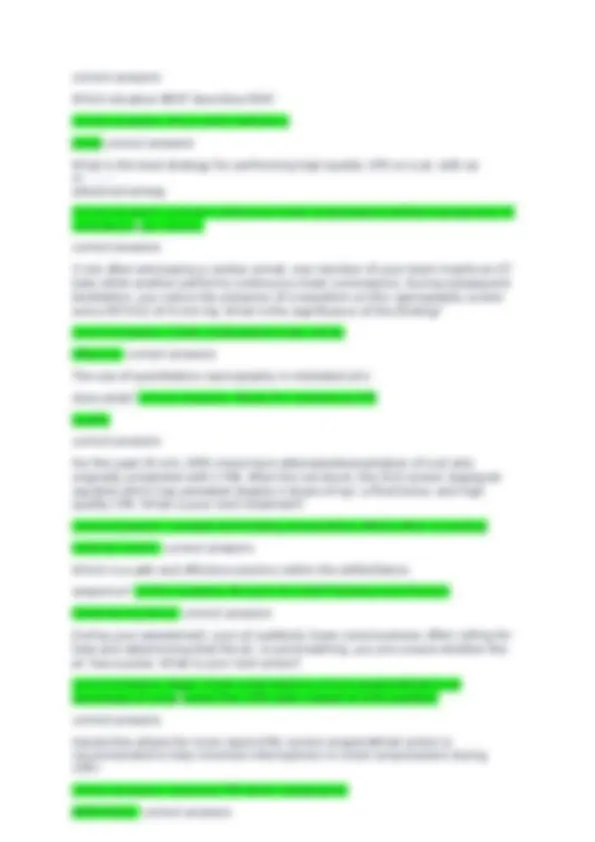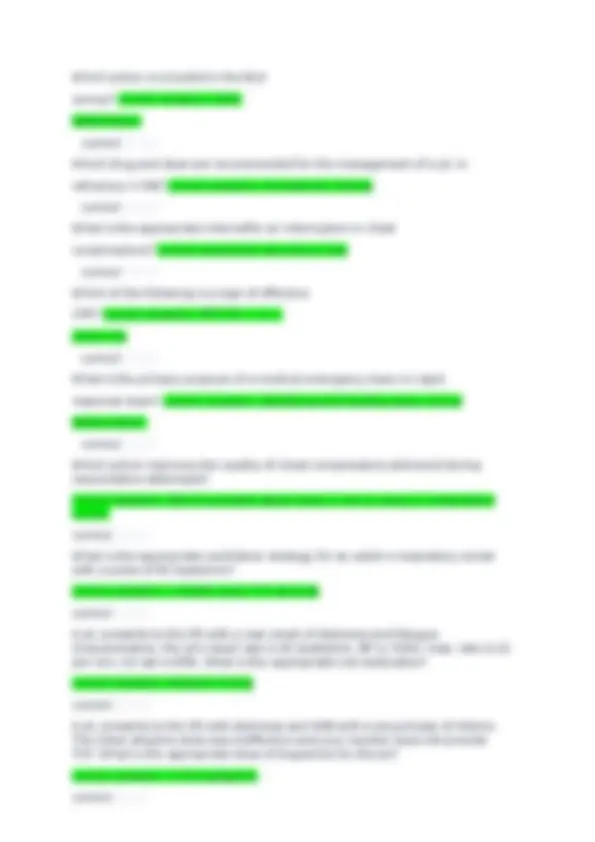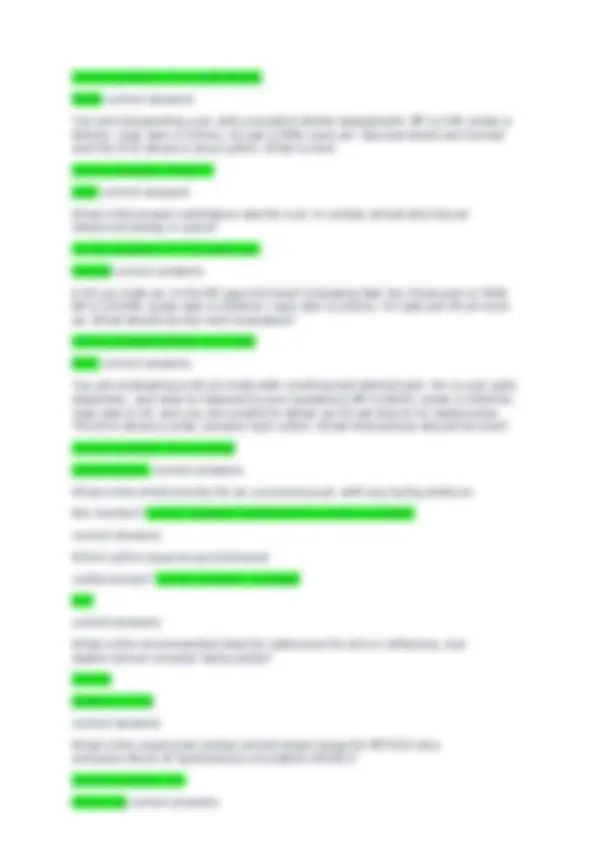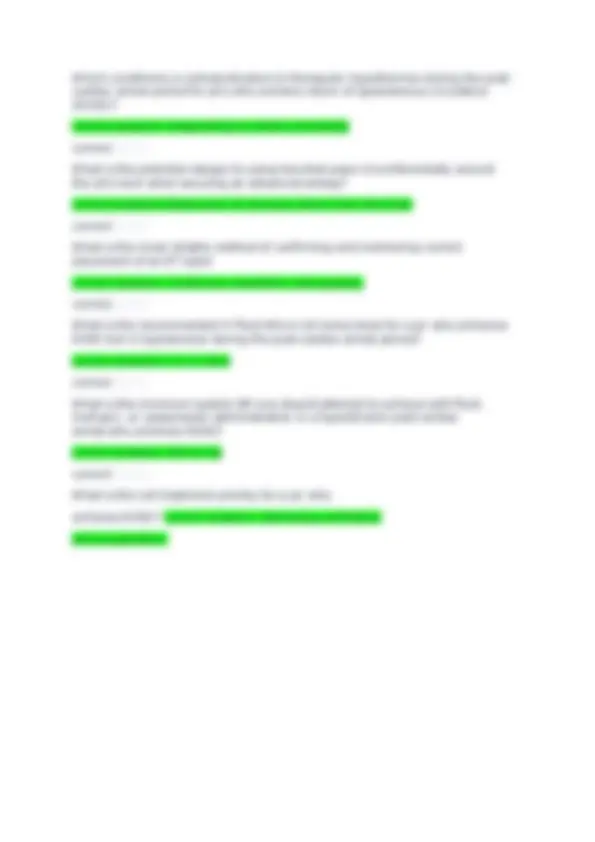








Study with the several resources on Docsity

Earn points by helping other students or get them with a premium plan


Prepare for your exams
Study with the several resources on Docsity

Earn points to download
Earn points by helping other students or get them with a premium plan
Community
Ask the community for help and clear up your study doubts
Discover the best universities in your country according to Docsity users
Free resources
Download our free guides on studying techniques, anxiety management strategies, and thesis advice from Docsity tutors
A series of questions and answers related to advanced cardiac life support (acls) procedures and protocols. It covers various scenarios, including cardiac arrest, arrhythmias, and other emergency medical situations. Designed to test knowledge and understanding of acls principles and practices.
Typology: Exams
1 / 11

This page cannot be seen from the preview
Don't miss anything!







You find an unresponsive patient who is not breathing. After activating the emergency response system, you determine there is no pulse. What is your next action? Correct answers: Start chest compressions of at least 100 per min. correct answers You are evaluating a 58 year old man with chest pain. The BP is 92/50 and a heart rate of 92/min, non-labored respiratory rate is 14 breaths/min and the pulse O2 is 97%. What assessment step is most important now? correct answers: Obtaining a 12 lead ECG.correct answersWhat is the preferred method of access for epi administration during cardiac arrest in most pts? Correct answers: Peripheral IV correct answers An AED does not promptly analyze a rythm. What is your next step? Correct answers: Begin chest compressions. correct answers You have completed 2 min of CPR. The ECG monitor displays the lead below (PEA) and the pt. has no pulse. You partner resumes chest compressions and an IV is in place. What management step is your next priority? Correct answers: Administer 1mg of epinepherine correct answers During a pause in CPR, you see a narrow complex rythm on the monitor. The pt. has no pulse. What is the next action? correct answers: Resume compressions correct answers What is a common but sometimes fatal mistake in cardiac arrest management? correct answers:Prolonged interruptions in chest compressions. correct answers Which action is a component of high-quality chest compressions? correct answers:Allowing complete chest recoil correct answers
Which action increases the chance of successful conversion of ventricular fibrillation? correct answers: Providing quality compressions immediately before a defibrillation attempt.
correct correct correct correct Which action is included in the BLS survey? correct answers: Early defibrillation correct Which drug and dose are recommended for the management of a pt. in refractory V-FIB? correct answers: Amioderone 300mg correct What is the appropriate intervalfor an interruption in chest compressions? correct answers10 seconds or less correct Which of the following is a sign of effective CPR? correct answers: PETCO2 = or > 10mm Hg correct What is the primary purpose of a medical emergency team or rapid response team? correct answers: Identifying and treating early clinical deterioration. correct Which action improves the quality of chest compressions delivered during resuscitative attemepts? correct answers: Shitch providers about every 2 min or every 5 compression cycles. What is the appropriate ventilation strategy for an adult in respiratory arrest with a pulse of 80 beats/min? correct answers: 1 breath every 5-6 seconds A pt. presents to the ER with a new onset of dizziness and fatugue. Onexamination, the pt's heart rate is 35 beats/min, BP is 70/50, resp. rate is 22 per min, O2 sat is 95%. What is the appropriate 1st medication? correct answers: Atropine 0.5mg A pt. presents to the ER with dizziness and SOB with a sinus brady of 40/min. The initial atropine dose was ineffective and your monitor does not provide TCP. What is the appropriate dose of Dopamine for this pt? correct answers: 2-10mcg/kg/min
is 78/min, resp rate is non-labored 14/min, 02 sat is 97%. Lead 2 in the ECG shows a sinus correct answers:Vagal manuever. correct answers A monitored pt. in the ICU developed a sudden onset of narrow complex tach at a rate of 220/min. The pt's BP is 128/58, the PETCO2 is 38mm Hg, and the O2 sat is 98%. There is an EJ established for vascular access. The pt. denies taking any vasodialators. A 12 lead shows no ischemia or infarction. Vagal maneuvers are ineffective. What is the next interventio correct answers: Adenosine 12mg IV correct answers You received a radio report from an EMS team enroute with a pt. who may be having a stroke. The hospital CT scanner is broken. What should you do? correct answers: Divert the pt. to a hospital 15 min away with CT capabilities. correct answers Choose an appropriate inidication to stop or withhold resuscitative efforts. correct answers: Evidence of rigor mortis. correct answers A 49 y/ofmaile arrives in the ER with persistant epigastric pain. She has been taking antacids PO for the past 6 hours because she had heartburn. BP is 118/72, heart rate is 92/min, resp. rate is 14 non-labored and O2 sat is 96%. What is the most appropriate next action? correct answers: Obtain a 12 lead ECG. correct answers A pt. in respiratory failure becomes apneic but continues to have a strong pulse. The heart rate is dropping paridly and now shows a sinus brady rate at 30/min. What intervention has the highest priority? correct answers: Simple airway manuevers and assisted ventilations. correct answers What is the appropriate procedure for ET suctioning after the catheter is selected? correct answers: Suction during withdrawl, but not for longer than 10 seconds. correct answers While treating a stable pt for dizziness, a BP of 68/30, cool and clammy, you see a brady rythm on the ECG. How do you treat this? correct answersAtropine 0.5mg correct answers: A 68 y/o female pt. experienced a sudden onset of right arm weakness. BP is 140/90, pulse rythm. What would be your next action?
correct answers: Cinncinati Stroke Scale correct answers You are transporting a pt. with a positive stroke assessment. BP is 138, pulse is 80/min, resp rate is 12/min, 02 sat is 95% room air. Glucose levels are normal and the ECG shows a sinus rythm. What is next. correct answers: Head CT scan correct answers What is the proper ventilation rate for a pt. in cardiac arrest who has an advanced airway in place? correct answers: 8-10 breaths per minute correct answers A 62 y/o male pt. in the ER says his heart is beating fast. No chest pain or SOB. BP is 142/98, pulse rate is 200/min, reps rate is 14/min, O2 sats are 95 at room air. What should be the next evaluation? correct answers:Obtain a 12 lead ECG. correct answers You are evaluating a 48 y/o male with crushing sub-sternal pain. He is cool, pale, diaphretic, and slow to respond to your questions. BP is 58/32, pulse is 190/min, resp rate is 18, and you are unable to obtain an 02 sat due to no radial pulse. The ECG shows a wide complex tach rythm. What intervention should be next? correct answers: Syncronized cardioversion. correct answers What is the initial priority for an unconscious pt. with any tachycardia on the monitor? correct answers: Determine if a pulse is present. correct answers Which rythm requires synchronized cardioversion? correct answers: Unstable SVT correct answers What is the recommended dose for adenosine for pt's in refractory, but stable narrow complex tachycardia? correct answers:12mg correct answers What is the usual post-cardiac arrest target range for PETCO2 who achieves return of spontaneous circulation (ROSC)? correct answers: 35- 40mm Hg correct answers
correct correct correct correct correct answers Which conditionis a contraindication to theraputic hypothermia during the post- cardiac arrest period for pt's who achieve return of spontaneous circulation (ROSC)? correct answers: Responding to verbal commands What is the potential danger to using ties that pass circumferentially around the pt's neck when securing an advanced airway? correct answers:Obstruction of veneous return from the brain What is the most reliable method of confirming and montioring correct placement of an ET tube? correct answers: Continuous waveform capnography What is the recommended IV fluid (NS or LR) bolus dose for a pt. who achieves ROSC but is hypotensive during the post-cardiac arrest period? correct answers:1 to 2 Liters What is the minimum systolic BP one should attempt to achieve with fluid, Inotropic, or vasopressor administration in a hypotensive post-cardiac arrest who achieves ROSC? correct answers: 90mm Hg What is the 1st treatment priority for a pt. who achieves ROSC? correct answers: Optimizing ventilation and oxygenation.